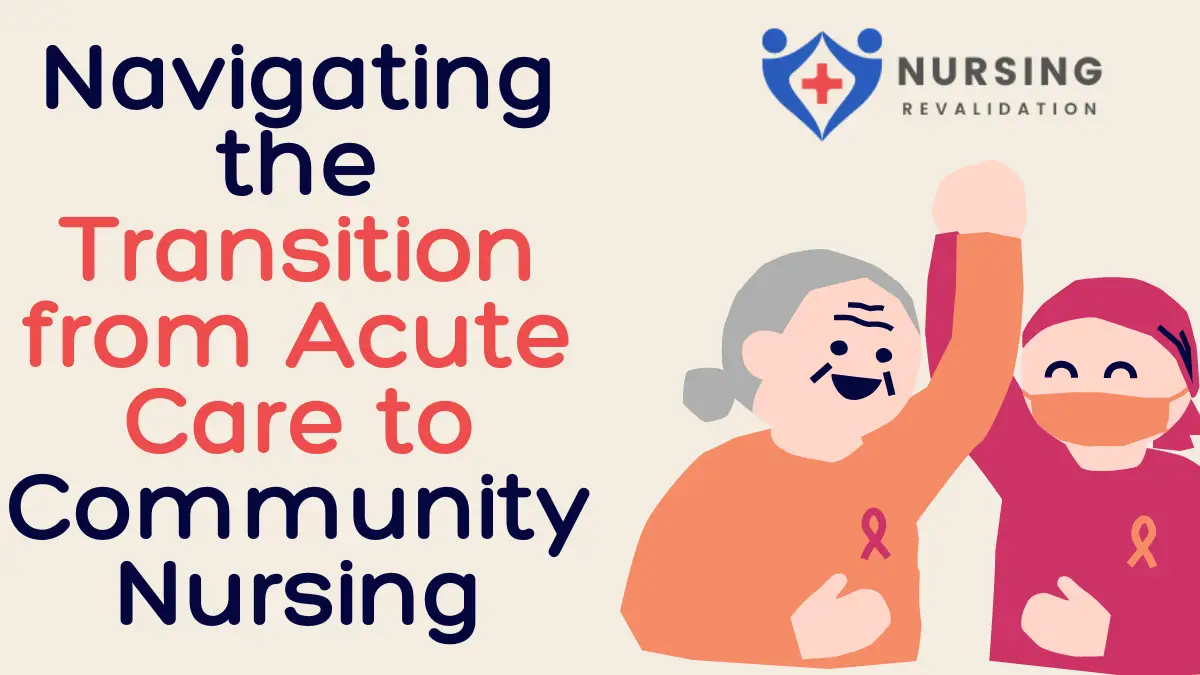In the realm of healthcare, the transition from acute care settings to community nursing presents unique challenges and opportunities. As patients move from hospitals or clinics back to their homes or communities, they require specialized care tailored to their individual needs. This comprehensive guide aims to explore the intricacies of this transition process, providing valuable insights for healthcare professionals and patients alike.
Understanding the Transition
Acute Care vs. Community Nursing
In acute care settings, patients receive intensive medical treatment for severe injuries or illnesses. These settings are characterized by round-the-clock monitoring, advanced medical technology, and specialized healthcare professionals. However, as patients stabilize or recover, they often transition to community nursing for ongoing care and support.
Challenges in Transition
The transition from acute care to community nursing is not without its challenges. Patients may experience anxiety or uncertainty about managing their health outside the hospital environment. Similarly, healthcare professionals must navigate logistical hurdles, such as coordinating home healthcare services and ensuring continuity of care.
Table: Key Components of a Successful Transition Plan
| Component | Description |
|---|---|
| Detailed Care Plans | Clearly outlined instructions for post-hospitalization care, including medication schedules. |
| Medication Management | Education on proper medication administration, potential side effects, and safety precautions. |
| Support Systems | Identification of family members, friends, or professional caregivers to provide assistance. |
| Care Coordination | Collaboration among healthcare professionals to address patients’ diverse needs. |
| Patient Education | Empowering patients to manage their health conditions through comprehensive education. |
| Continuous Monitoring | Regular follow-up appointments and remote monitoring to assess patients’ progress. |
Key Considerations for Patients
Understanding Care Plans
Upon discharge from acute care, patients should receive detailed care plans outlining their post-hospitalization needs. These plans typically include medication schedules, dietary recommendations, and instructions for managing medical equipment. Patients should review these plans with their healthcare providers to ensure clarity and understanding.
Managing Medications
One of the most critical aspects of transitioning to community nursing is medication management. Patients must understand their prescribed medications, including dosages, potential side effects, and proper administration techniques. Healthcare professionals should educate patients and caregivers on medication safety practices to minimize the risk of errors.
Support Systems
Building a robust support system is essential for patients transitioning to community nursing. This may involve enlisting the help of family members, friends, or professional caregivers to assist with daily tasks, transportation to medical appointments, and emotional support. Community resources, such as support groups or home healthcare services, can also play a vital role in facilitating this transition.
Roles and Responsibilities of Healthcare Professionals
Care Coordination
Effective care coordination is paramount in ensuring a smooth transition from acute care to community nursing. Healthcare professionals, including nurses, physicians, social workers, and case managers, must collaborate closely to address patients’ diverse needs. This may involve scheduling follow-up appointments, arranging home healthcare services, and communicating with primary care providers.
Patient Education
Healthcare professionals play a crucial role in educating patients and their families about managing health conditions outside the hospital setting. This may include providing instructions on wound care, administering medications, monitoring vital signs, and recognizing signs of complications. Clear, concise education materials and demonstrations can empower patients to take an active role in their healthcare journey.
Continuous Monitoring and Assessment
Even after transitioning to community nursing, patients require ongoing monitoring and assessment to ensure optimal health outcomes. Healthcare professionals should establish regular follow-up appointments to evaluate patients’ progress, address any concerns or complications, and adjust treatment plans as needed. Remote monitoring technologies, such as telehealth platforms and wearable devices, can enhance communication and surveillance between patients and providers.
Conclusion
Navigating the transition from acute care to community nursing requires careful planning, communication, and collaboration among patients, caregivers, and healthcare professionals. By understanding the challenges involved and implementing proactive strategies, patients can achieve successful outcomes and maintain their health and independence in the community setting. With a comprehensive approach focused on patient-centered care, we can optimize the transition process and improve overall healthcare outcomes for all stakeholders involved.

